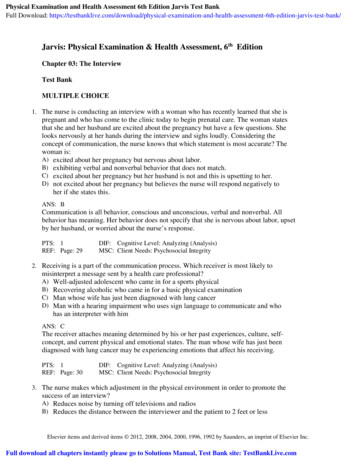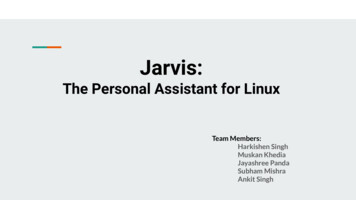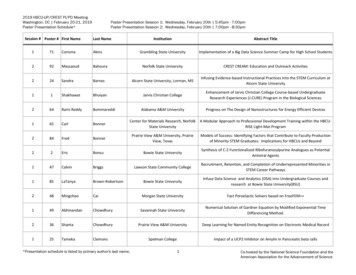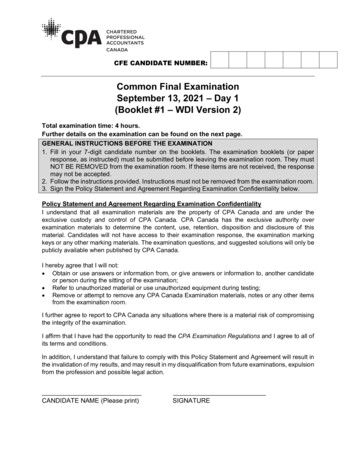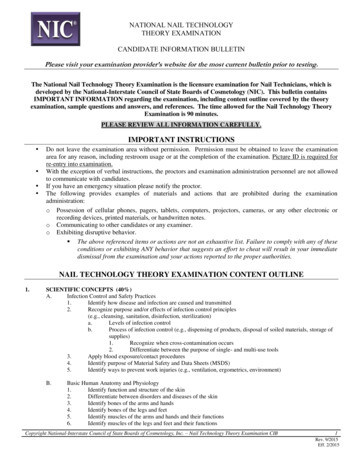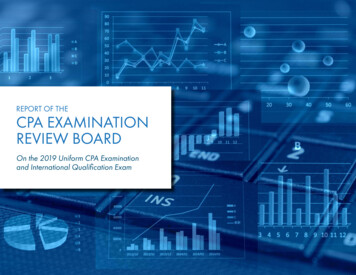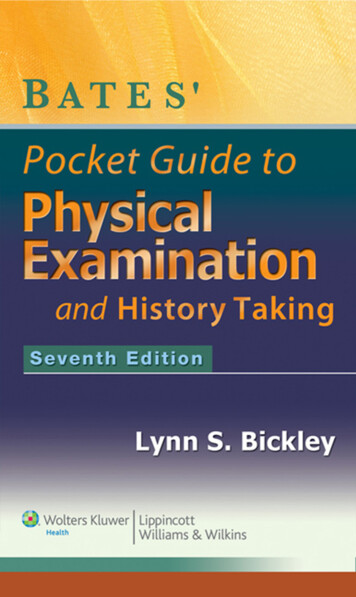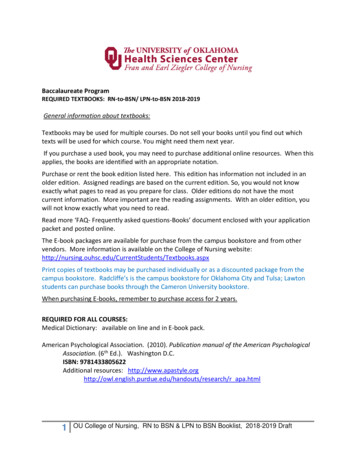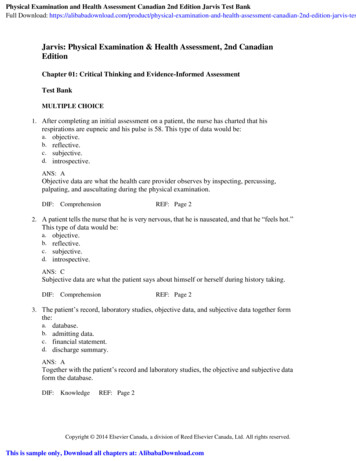
Transcription
Physical Examination and Health Assessment Canadian 2nd Edition Jarvis Test BankFull Download: jarvis-tesJarvis: Physical Examination & Health Assessment, 2nd CanadianEditionChapter 01: Critical Thinking and Evidence-Informed AssessmentTest BankMULTIPLE CHOICE1. After completing an initial assessment on a patient, the nurse has charted that hisrespirations are eupneic and his pulse is 58. This type of data would be:a. objective.b. reflective.c. subjective.d. introspective.ANS: AObjective data are what the health care provider observes by inspecting, percussing,palpating, and auscultating during the physical examination.DIF: ComprehensionREF: Page 22. A patient tells the nurse that he is very nervous, that he is nauseated, and that he “feels hot.”This type of data would be:a. objective.b. reflective.c. subjective.d. introspective.ANS: CSubjective data are what the patient says about himself or herself during history taking.DIF: ComprehensionREF: Page 23. The patient’s record, laboratory studies, objective data, and subjective data together formthe:a.b.c.d.database.admitting data.financial statement.discharge summary.ANS: ATogether with the patient’s record and laboratory studies, the objective and subjective dataform the database.DIF: KnowledgeREF: Page 2Copyright 2014 Elsevier Canada, a division of Reed Elsevier Canada, Ltd. All rights reserved.This is sample only, Download all chapters at: AlibabaDownload.com
Test Bank1-24. When listening to a patient’s breath sounds, the nurse is unsure about a sound that is heard.The nurse should:a. notify the patient’s physician immediately.b. document the sound exactly as it was heard.c. validate the data by asking a colleague to listen to the breath sounds.d. assess again in 20 minutes to note whether the sound is still present.ANS: CValidate any data when you need to ensure their accuracy. If you have less experience in anarea, ask an expert to listen to the sound.DIF: AnalysisREF: Page 35. Novice nurses, without a background of skills and experience to draw from, are more likelyto make their decisions using:a. intuition.b. a set of rules.c. articles in journals.d. advice from supervisors.ANS: BNovice nurses operate from a set of rules (such as the nursing process).DIF: ComprehensionREF: Page 36. Expert nurses learn to attend to a pattern of assessment data and act without consciouslylabelling it. This is referred to as:a. intuition.b. the nursing process.c. clinical knowledge.d. diagnostic reasoning.ANS: AIntuition is characterized by pattern recognition; expert nurses learn to attend to a pattern ofassessment data and act without consciously labelling it.DIF: ComprehensionREF: Page 37. Critical thinking in the expert nurse is greatly enhanced by opportunities to:a. apply theory in real situations.b. work with physicians to provide patient care.c. follow physician orders in providing patient care.d. develop nursing diagnoses for commonly occurring illnesses.ANS: ACritical thinking is the means by which nurses learn to assess and modify, if indicated,before acting, and this happens in the clinical setting. The depth and breadth of expertknowledge, largely gained from opportunities to apply theory in real situations, greatlyenhances a nurse’s critical thinking ability.Copyright 2014 Elsevier Canada, a division of Reed Elsevier Canada, Ltd. All rights reserved.
Test BankDIF: Comprehension1-3REF: Page 48. Which of the following is an example of a first-level priority problem?a. A patient with postoperative painb. A patient newly diagnosed with diabetes who needs teaching about diabetesc. An individual with a small laceration on the sole of the footd. An individual with shortness of breath and respiratory distressANS: DFirst-level priority problems are those that are emergent, are life-threatening, and requireimmediate action (e.g., establishing airway, supporting breathing, maintaining circulation,and monitoring vital signs).DIF: ComprehensionREF: Page 69. Which of the following are considered second-level priority problems?a. Low self-esteemb. Lack of knowledgec. Abnormal laboratory valuesd. Severely abnormal vital signsANS: CSecond-level priority problems are those that require prompt intervention to preventfurther deterioration (e.g., mental status change, acute pain, abnormal laboratory values,and risks to safety or security).DIF: ComprehensionREF: Page 610. Which critical thinking skill helps the nurse recognize relationships among data?a. Validationb. Clustering-related cuesc. Identifying gaps in datad. Distinguishing relevant from irrelevantANS: BClustering-related cues help the nurse recognize relationships among data.DIF: ComprehensionREF: Page 511. The nurse knows that developing appropriate nursing interventions for a patient relies onthe appropriateness of the:a. nursing diagnosis.b. medical diagnosis.c. admission diagnosis.d. collaborative diagnosis.ANS: ACopyright 2014 Elsevier Canada, a division of Reed Elsevier Canada, Ltd. All rights reserved.
Test Bank1-4An accurate nursing diagnosis provides the basis for selecting nursing interventions toachieve outcomes for which the nurse is accountable.DIF: ComprehensionREF: Page 512. Which six phases are included in the nursing process?a. Assessment, treatment, client outcome, evaluation, discharge, follow-upb. Admission, assessment, outcome identification, diagnosis, treatment, dischargeplanningc. Admission, diagnosis, expected outcome, treatment, evaluation, discharge planningd. Assessment, diagnosis, outcome identification, planning, implementation,evaluationANS: DThe nursing process is a method of problem solving that includes assessment, diagnosis,outcome identification, planning, implementation, and evaluation.DIF: ComprehensionREF: Page 313. A newly admitted patient is in acute pain, has not been sleeping well lately, and is havingdifficulty breathing. How should the nurse prioritize these problems?a. Breathing, pain, sleepb. Breathing, sleep, painc. Sleep, breathing, paind. Sleep, pain, breathingANS: AFirst-level priority problems are immediate priorities (remember the ABCs), followed bysecond-level problems, and then third-level problems.DIF: AnalysisREF: Page 614. Which of the following would be formulated by a nurse using diagnostic reasoning?a. Nursing diagnosisb. Medical diagnosisc. Diagnostic hypothesisd. Diagnostic assessmentANS: CDiagnostic reasoning calls for the nurse to formulate a diagnostic hypothesis; the nursingprocess calls for a nursing diagnosis.DIF: ComprehensionREF: Page 215. A nursing diagnosis made by a critical thinker using a dynamic nursing process wouldidentify the actual problem and would also:a. continue to reassess.b. predict potential problems.c. check the appropriateness of goals.Copyright 2014 Elsevier Canada, a division of Reed Elsevier Canada, Ltd. All rights reserved.
Test Bank1-5d. modify the diagnosis if necessary.ANS: BA dynamic nursing process, as used by a critical thinker, would include under diagnoses:diagnoses of actual problems, prediction of potential problems, and identification ofstrengths.DIF: ComprehensionREF: Page 516. What is the step of the nursing process that includes data collection through health historytaking, physical examination, and interview?a. Planningb. Diagnosisc. Evaluationd. AssessmentANS: DData collection, which includes conducting health history taking, physical examination,and interview, is the assessment step of the nursing process.DIF: KnowledgeREF: Page 217. Which of the following statements illustrates the biomedical model of Western traditionalviews?a. Health is viewed as the absence of disease.b. Optimal health is viewed as high-level wellness.c. Health and disease are considered parts of a cyclical process.d. The treatment of disease is nursing’s primary focus.ANS: AThe biomedical model of Western tradition views health as the absence of disease.DIF: KnowledgeREF: Page 818. The public’s concept of health has changed since the 1950s. Which of the followingstatements most accurately describes this change?a. Lifestyle, personal habits, exercise, and nutrition are essential to health.b. Assessment of health is critical to identifying disease-causing pathogens.c. Accurate diagnosis and treatment by a physician are essential for all health care.d. An individual is considered healthy when signs and symptoms of disease have beeneliminated.ANS: AThe accurate diagnosis and treatment of illness are still considered important parts ofhealth care, but the public’s concept of health has expanded since the 1950s. We have anincreasing interest in lifestyle, personal habits, exercise and nutrition, and social andnatural environments.DIF: ComprehensionREF: Page 8Copyright 2014 Elsevier Canada, a division of Reed Elsevier Canada, Ltd. All rights reserved.
Test Bank1-619. Why is the concept of prevention essential in describing health?a. Disease can be prevented by treating the external environment.b. Most deaths among Canadians under age 65 are not preventable.c. Prevention places emphasis on the link between health and personal behaviour.d. The means to prevention is through treatment provided by primary health carepractitioners.ANS: CA natural progression to prevention now rounds out our concept of health. Guidelines toprevention place emphasis on the link between health and personal behaviour.DIF: ComprehensionREF: Pages 5, 820. Which of the following statements about nursing diagnoses is true? Nursing diagnoses:a. evaluate the etiology of disease.b. are a process based on medical diagnosis.c. evaluate the response of the whole person to actual or potential health problems.d. focus on the function and malfunction of a specific organ system in response todisease.ANS: CNursing diagnoses are used to evaluate the response of the whole person to actual orpotential health problems.DIF: KnowledgeREF: Page 621. An example of objective information obtained during the physical assessment includes thepatient’s:a. history of allergies.b. use of medications at home.c. last menstrual period.d. 2 5 cm scar present on the right forearm.ANS: DObjective data comprise the patient’s record, results of laboratory studies, and informationthat the health care provider obtains by inspecting, percussing, palpating, and auscultatingthe patient during the physical examination.DIF: ApplicationREF: Page 222. A visiting nurse is making an initial home visit to a patient who has a number of chronicmedical problems. Which type of database is most appropriate to collect in this setting?a. A follow-up database to evaluate changes at appropriate intervalsb. An episodic database because of the continuing, complex medical problems of thispatientc. A complete health database because of the nurse’s primary responsibility formonitoring the patient’s healthd. An emergency database because of the need to rapidly collect information and makeCopyright 2014 Elsevier Canada, a division of Reed Elsevier Canada, Ltd. All rights reserved.
Test Bank1-7accurate diagnosesANS: CThe complete database is collected in a primary care setting, such as a pediatric or familypractice clinic, independent or group private practice, college health service, women’shealth care agency, visiting nurse agency, or community health care agency. In thesesettings, the nurse is the first health care provider to see the patient and has the primaryresponsibility for monitoring the person’s health care.DIF: ApplicationREF: Page 923. Which of the following situations is most appropriate for an episodic history?a. A patient’s admission to a long-term care facilityb. A patient having sudden, severe shortness of breathc. A patient’s admission to the hospital for surgery the following dayd. A patient having cold and flulike symptoms and seen in an outpatient clinicANS: DIn an episodic or problem-centred database, the nurse collects a “mini” database, smaller inscope than a complete database. It concerns mainly one problem, one cue complex, or onebody system.DIF: ApplicationREF: Page 1024. A patient is at the clinic to have her blood pressure checked. She has been coming to theclinic weekly since her medications were changed 2 months ago. The nurse should:a. collect a follow-up database and then check the patient’s blood pressure.b. ask the patient to read her health record and indicate any changes since her last visit.c. check only the blood pressure because the patient’s complete health history wasdocumented 2 months ago.d. obtain a complete health history before checking the blood pressure because muchof the patient’s information may have changed.ANS: AA follow-up database is used in all settings to follow up short-term or chronic healthproblems.DIF: ApplicationREF: Page 1025. A patient is brought by ambulance to the emergency department with multiple injuriesreceived in an automobile accident. He is alert and cooperative, but his injuries are quitesevere. How should the nurse proceed with the data collection?a. Collect history information first, perform the physical examination next, andinstitute lifesaving measures.b. Ask history questions while performing the examination and initiating lifesavingmeasures.c. Collect all information on the history form, including social support patterns,strengths, and coping patterns.d. Perform lifesaving measures and not ask any history questions until after the patientCopyright 2014 Elsevier Canada, a division of Reed Elsevier Canada, Ltd. All rights reserved.
Test Bank1-8has been transferred to the critical care unit.ANS: BThe emergency database calls for rapid collection of the database, often compiled whileperforming lifesaving measures.DIF: AnalysisREF: Page 1026. Which of the following statements is a characteristic of the clinical practice guidelines forinfants and children for a periodic health examination?a. They are used to diagnose an illness.b. They are helpful in identifying developmental delays in children.c. They recommend that every individual receive an annual physical examination.d. They list a frequency schedule for periodic health visits for a specific age group.ANS: DThey include schedules for periodic well-child assessments, as well as other topics.DIF: KnowledgeREF: Page 1027. A 42-year-old patient of Asian descent is being seen at the clinic for an initial examination.The nurse knows that it is important to include cultural information in his healthassessment to:a. identify the cause of his illness.b. make an accurate diagnosis.c. provide cultural health rights for the individual.d. provide culturally sensitive and appropriate care.ANS: DThe inclusion of cultural considerations in the health assessment is of paramountimportance to let nurses effectively and respectfully explore the interrelated biological,social, cultural, and economic factors.DIF: ComprehensionREF: Page 1128. In the socioenvironmental model, the focus of the health care provider includes:a. changing the patient’s perceptions of disease.b. identification of biomedical model interventions.c. identifying the negative health behaviours of the patient.d. helping the patient view health as a resource.ANS: DIn the socioenvironmental model, the focus of the health care provider is on helping theconsumer choose a healthier lifestyle.DIF: KnowledgeREF: Page 829. Which of the following would be included in a total health database for a well person?a. Nursing goals for the patientCopyright 2014 Elsevier Canada, a division of Reed Elsevier Canada, Ltd. All rights reserved.
Test Bank1-9b. Anticipated growth and development patternsc. A patient’s perception of his or her health statusd. The nurse’s perception of disease as related to this patientANS: CA total health database for the well person includes the person’s health state, perception ofhealth, strengths or assets such as the ability to engage in health maintenance orhealth-promoting practices, support systems, current developmental tasks, and any riskfactors or social issues.DIF: ComprehensionREF: Page 930. When nursing diagnoses are being classified, which of the following would be considereda risk diagnosis?a. Identifying existing levels of wellnessb. Evaluating previous problems and goalsc. Identifying potential problems the individual may developd. Focusing on strengths and reflecting an individual’s transition to higher levels ofwellnessANS: CRisk diagnoses are problems that an individual does not currently have but is particularlyvulnerable to develop.DIF: ApplicationREF: Page 531. The nurse has implemented several planned interventions to address the nursing diagnosisof acute pain. Which of the following would be the next appropriate action?a. Establishing prioritiesb. Identifying expected outcomesc. Evaluating the individual’s condition and comparing actual outcomes with expectedoutcomesd. Interpreting data, identifying clusters of cues, and making inferencesANS: CEvaluation is the next step after the implementation phase of the nursing process. Duringthis step, the nurse should evaluate the individual’s condition and compare actual outcomeswith expected outcomes.DIF: ApplicationREF: Pages 3, 432. Which of the following best describes a proficient nurse?a. A nurse who has little experience with a specified population and uses rules to guideperformanceb. A nurse who has an intuitive grasp of a clinical situation and quickly identifies theaccurate solutionc. A nurse who sees actions in the context of daily plans for patientsd. A nurse who sees a patient’s situation as a whole, with long-term goals for thepatient, rather than as a list of tasks to be performedCopyright 2014 Elsevier Canada, a division of Reed Elsevier Canada, Ltd. All rights reserved.
Physical Examination and Health Assessment Canadian 2nd Edition Jarvis Test BankFull Download: jarvis-tesTest Bank1-10ANS: DThe proficient nurse, who has practised longer and has more experience than has the novicenurse, is able to see a patient’s situation as a whole, rather than as a list of tasks to beperformed, and is able to see how today’s nursing actions apply to the point the nurse wantsthe patient to reach at a future time.DIF: ApplicationREF: Page 3MATCHINGPrioritize the following patient situations:A first-level priority problemB second-level priority problemC third-level priority problem1. A patient newly diagnosed with type 2 diabetes mellitus who does not know how to checkhis own blood glucose levels with a glucometer2. A teenager who was stung by a bee during a soccer match is having trouble breathing3. An older adult with urinary tract infection who is showing signs of confusion and agitation1. ANS: B2. ANS: C3. ANS: ADIF: AnalysisDIF: AnalysisDIF: AnalysisREF: Page 6REF: Page 6REF: Page 6Copyright 2014 Elsevier Canada, a division of Reed Elsevier Canada, Ltd. All rights reserved.This is sample only, Download all chapters at: AlibabaDownload.com
An accurate nursing diagnosis provides the basis for selecting nursing interventions to achieve outcomes for which the nurse is accountable. DIF: Comprehension REF: Page 5 12. Which six phases are included in the nursing process? a. Assessment, treatment, client outcome, evaluation, discharge, follow-up b.
